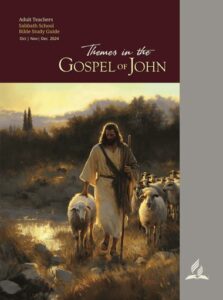Introduction: Themes in the Gospel of John
Sitting in a shop in Tehran, Iran, the Persion rug depicted an ancient forest. Beautifully done, it re-created a scene in Switzerland: mountains, a waterfall, a turquoise lake, forested hillsides, and an expansive blue sky dotted with clouds.
Anyone in that shop could have spent their time noting the details: the number of knots per square inch, the fabric of the carpet, the types of dye used–all the minutiae that resulted in the rug.
Or the person could have focused, instead, on the arresting techniques and themes that gave the carpet its unique beauty: the sky reflected in the lake, the snow that capped the mountains, the verdant forest complimented by the deep green moss. The themes of the carpet combined with one another in a deftly coordinated display of beauty to manifest the splendor of that serene of the Alps.
This quarter we will be studying another finely crafted masterpiece. This work is not the result of a brush on canvas, a precisely framed photograph, or a skilfully woven carpet. Rather it is the Word of God as artfully expressed in the Gospel of John.
Words have meaning within their contexts. For anyone to understand what Scripture intends to say, it must be studied in context–the immediate sentences, chapters, and sections, and the overall message of the Bible itself. Finally, because the entire Bible is inspired by the Holy Spirit, each part should be studied in the context of the whole.
The intention this quarter will be to understand the message of John’s Gospel. It is unique among the four Gospels, often focusing attention on personal interviews between Jesus and just one or two people–such as the Nathaniel, Nicodemus, the woman at the well, the paralytic at the pool of Bethesda, the man born blind, Lazarus and his sisters, Pilate, Peter, or Thomas. Many of these stories appear only in John.
| May the Gospel of John carry us back in the life and ministry of Jesus Christ whom to know is life etrenal. |
The Gospel of John is the Word of God conveyed to us through the apostle. As with the entire Bible, the Gospel came by the will of God, rather than by the will of man. John was merely the willing instrument the Holy Spirit used to convey many crucial themes: the Word (logos), light, bread, water, the Holy Spirit, oneness, signs, testimony, and prophecy. These themes mutually enhance and illuminate one another throughout the Gospel.
Bible study often concentrates on the meaning of a word or a small passage of Scripture. We check the meaning of the word in a Bible dictionary. We examine the grammar, the immediate context, and the historical context; and –using our analogy of the carpet–we grt caught up in the examination of the number of knots per square inch, the fabric, the dyes, and the backing. All of these details are important.
But let us not miss the big picture while examining the details. Indeed, just as the Persian carpet could transport someone to the beautiful Alpine scene, so may the Gospel of John carry us back to the life and ministry of Jesus Christ, whom to know is life eternal. The details have a role, which is to point us toward the big picture, and in John that big picture is a divinely inspired revelation of Jesus, our Lord and Savior.
E. Edward Zinke, a former associate director for the Biblical Research Institute at the General Conference of Seventh-day Adventists, is involved with many church activities and boards, including serving as vice chair of the Ellen G. White Estate Baord and as a senior advisor for the Adventist Review Ministries. He holds three honorary doctorate degrees from Seventh-day Adventist universities. He lives in Maryland.
Thomas Shepherd PhD, DrPH, is senior research professor of New Testament at the Andrews University Seventh-day Adventist Theological Seminary, where he has taught since 2008. He and his wife, Sherry Shepherd, MD, have served as missionaries in Malawi, Africa, and Brazil. They have two grown children and six grandchilren.


Aashish Singh, the lesson quarterly is available as an app through the App Store for Apple, or Play Store for Android. I use the Sabbath School Quarterly app by Rusek Ministries and am very happy with it.
Looking forward to this quarter’s lesson study. A minor observation for the editor regarding where Thomas Shepherd PhD, DrPH, has served…Malawi is in Africa 🙂
May God continually inspire the Sabbath School team for the great work they do, this guide has led many people to Christ. The reward is Great in the Kingdom above press on Soldiers of Christ.